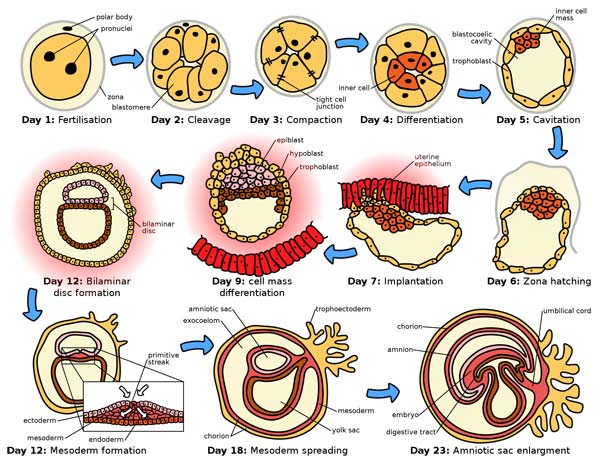embryo

The initial stages of human embryonic development
An embryo is an early stage of development of an animal – before birth, from the zygote (fertilized ovum) through the differentiation of the major organs. In humans, the fertilized ovum divides repeatedly, forming a small ball of cells called a blastocyst which fixes by implantation to the wall of the uterus (womb); differentiation into placenta and three primitive layers (endoderm, mesoderm, and ectoderm) follows. These layers then undergo further division into distinct organ precursors and each of these develops by a process of migration, differentiation, and differential growth. The processes roughly correspond to the phylogeny or evolutionary sequence leading to the species.
Much of embryonic development depends on the formation of cavities, either by splitting of layers or by enfolding. The heart develops early at the front, probably splitting into a simple tube, before being divided into separate chambers; the gut is folded into the body, although for a long time the bulk of it remains outside. The nervous system develops as an infolding of ectoderm, which then becomes separated from the surface (for more details, see neural tube). Facial development consists of mesodermal migration and modification of the bronchial arches, remnants of the gills in phylogeny; primitive limb buds grow out of the developing trunk.
The overall control of these processes is not yet fully understood; however, infection (especially rubella) in the mother, or the taking of certain drugs (e.g., thalidomide) during pregnancy may lead to abnormal development and so to congenital defects, including heart defects, limb deformity, harelip and cleft palate, and spina bifida. By convention, the embryo becomes a fetus at three months gestation.
Week by week changes of the human embryo
The following list describes specific changes that occur in the womb:
Week 3 of gestation
The brain, spinal cord, and heart begin to develop.
The gastrointestinal tract begins to develop.
Weeks 4 to 5
Arm and leg buds become visible.
Brain develops into five areas and some cranial nerves are visible.
Eyes and ear structures begin to form.
Formation of tissue that develops into the vertebra and some other
bones.
Further development of the heart which now beats at a regular
rhythm.
Movement of rudimentary blood through the main vessels.
Week 6
Arms and legs have grown longer, and foot and hand areas can be
distinguished.
Hands and feet have fingers and toes (digits), but may still be
webbed.
Brain continues to form.
Lungs begin to form.
Week 7
Nipples and hair follicles form.
Elbows and toes visible.
All essential organs have begun to form.
Week 8
Eyelids are more developed.
External features of the ear begin to take their final shape.
Facial features continue to develop.
Intestines rotate.
The end of the eighth week marks the end of the "embryonic period" and the beginning of the "fetal period".
Weeks 9 to 12
Eyelids close and will not reopen until about the 28th week.
Face is well formed.
Limbs are long and thin.
Genitals appear well differentiated.
Red blood cells are produced in the liver.
The head makes up nearly half of the fetus' size.
The baby can make a fist with its fingers.
Tooth buds appear for the baby teeth.
Weeks 13 to 16
Fetal skin is almost transparent.
Fine hair called lanugo develops on the head.
Meconium is made in the intestinal tract.
More muscle tissue and bones have developed, and the bones become
harder.
The baby begins to make active movements.
The liver and pancreas produce fluid secretions.
Sucking motions are made with the mouth.
Weeks 17 to 19
Baby can hear.
Baby makes more movements.
Mother may feel a fluttering in the lower abdomen.
Week 20
Lanugo hair covers entire body.
Eyebrows and lashes appear.
Nails appear on fingers and toes.
The baby is more active with increased muscle development.
Mother can feel the baby moving.
Fetal heartbeat can be heard with a stethoscope.
Weeks 21 to 23
Bone marrow begins to make blood cells.
The lower airways of the baby's lungs develop but still do not
produce surfactant (a substance that allows the alveoli to open
for gas exchange).
Baby begins to store fat.
Week 24
Eyebrows and eyelashes are well formed.
All eye parts are developed.
The baby has a hand and startle reflex.
Footprints and fingerprints forming.
Air sacs form in lungs.
Weeks 25 to 28
Rapid brain development.
Nervous system developed enough to control some body functions.
Eyelids open and close.
Respiratory system, while immature, has developed to the point
where gas exchange is possible.
Weeks 29 to 32
Rapid increase in the amount of body fat.
Rhythmic breathing movements occur, but lungs are not fully mature.
Bones are fully developed, but still soft and pliable.
Baby's body begins storing iron, calcium, and phosphorus.
Week 36
Lanugo begins to disappear.
Body fat increases.
Fingernails reach the end of the fingertips.
Weeks 37 to 40
Lanugo is gone except for on the upper arms and shoulders.
Fingernails extend beyond fingertips.
Small breast buds are present on both sexes.
Head hair is now coarse and thicker


